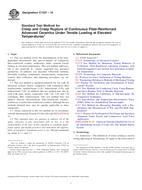Potrebujeme váš súhlas na využitie jednotlivých dát, aby sa vám okrem iného mohli ukazovať informácie týkajúce sa vašich záujmov. Súhlas udelíte kliknutím na tlačidlo „OK“.
ASTM C1337-10
Standard Test Method for Creep and Creep Rupture of Continuous Fiber-Reinforced Advanced Ceramics Under Tensile Loading at Elevated Temperatures
Automaticky preložený názov:
Štandardná skúšobná metóda pre dotvarovanie a tečenie spojitých vystužených vláknami pokročilých keramiky Podľa ťahovom zaťažení pri zvýšených teplotách
NORMA vydaná dňa 1.12.2010
Informácie o norme:
Označenie normy: ASTM C1337-10
Poznámka: NEPLATNÁ
Dátum vydania normy: 1.12.2010
Kód tovaru: NS-10748
Počet strán: 11
Približná hmotnosť: 33 g (0.07 libier)
Krajina: Americká technická norma
Kategória: Technické normy ASTM
Anotácia textu normy ASTM C1337-10 :
Keywords:
ceramic matrix composite, CFCC, continuous fiber ceramic composite, creep rupture, creep test, elevated temperature, Ceramic composites, Composites, Continuous fiber-reinforced ceramic composites (CFCC), Creep, Creep rupture, Elevated temperature tests, Fiber-reinforced composites, Tensile loading, ICS Number Code 19.060 (Mechanical testing), 81.060.99 (Other standards related to ceramics), 81.060.30 (Advanced ceramics)
Doplňujúce informácie
| Significance and Use | ||||||||||||||||||||||||
|
This test method may be used for material development, material comparison, quality assurance, characterization, and design data generation. Continuous fiber-reinforced ceramic matrix composites are candidate materials for structural applications requiring high degrees of wear and corrosion resistance and toughness at high temperatures. Creep tests measure the time-dependent deformation of a material under constant load at a given temperature. Creep rupture tests provide a measure of the life of the material when subjected to constant mechanical loading at elevated temperatures. In selecting materials and designing parts for service at elevated temperatures, the type of test data used will depend on the criteria for load-carrying capability which best defines the service usefulness of the material. Creep and creep rupture tests provide information on the time-dependent deformation and on the time-of-failure of materials subjected to uniaxial tensile stresses at elevated temperatures. Uniform stress states are required to effectively evaluate any nonlinear stress-strain behavior which may develop as the result of cumulative damage processes (for example, matrix cracking, matrix/fiber debonding, fiber fracture, delamination, etc.) which may be influenced by testing mode, testing rate, processing or alloying effects, environmental influences, or elevated temperatures. Some of these effects may be consequences of stress corrosion or subcritical (slow) crack growth. It is noted that ceramic materials typically creep more rapidly in tension than in compression. Therefore, creep data for design and life prediction should be obtained in both tension and compression. The results of tensile creep and tensile creep rupture tests of specimens fabricated to standardized dimensions from a particular material or selected portions of a part, or both, may not totally represent the creep deformation and creep rupture properties of the entire, full-size end product or its in-service behavior in different environments or at various elevated temperatures. For quality control purposes, results derived from standardized tensile test specimens may be considered indicative of the response of the material from which they were taken for given primary processing conditions and post-processing heat treatments. |
||||||||||||||||||||||||
| 1. Scope | ||||||||||||||||||||||||
|
1.1 This test method covers the determination of the time-dependent deformation and time-to-rupture of continuous fiber-reinforced ceramic composites under constant tensile loading at elevated temperatures. This test method addresses, but is not restricted to, various suggested test specimen geometries. In addition, test specimen fabrication methods, allowable bending, temperature measurements, temperature control, data collection, and reporting procedures are addressed. 1.2 This test method is intended primarily for use with all advanced ceramic matrix composites with continuous fiber reinforcement: unidirectional (1-D), bidirectional (2-D), and tridirectional (3-D). In addition, this test method may also be used with glass matrix composites with 1-D, 2-D, and 3-D continuous fiber reinforcement. This test method does not address directly discontinuous fiber-reinforced, whisker-reinforced, or particulate-reinforced ceramics, although the test methods detailed here may be equally applicable to these composites. 1.3 Values expressed in this test method are in accordance with the International System of Units (SI) and . 1.4 This standard does not purport to address all of the safety concerns, if any, associated with its use. It is the responsibility of the user of this standard to establish appropriate safety and health practices and determine the applicability of regulatory limitations prior to use. Hazard statements are noted in 7.1 and 7.2. |
||||||||||||||||||||||||
| 2. Referenced Documents | ||||||||||||||||||||||||
|




 Cookies
Cookies
